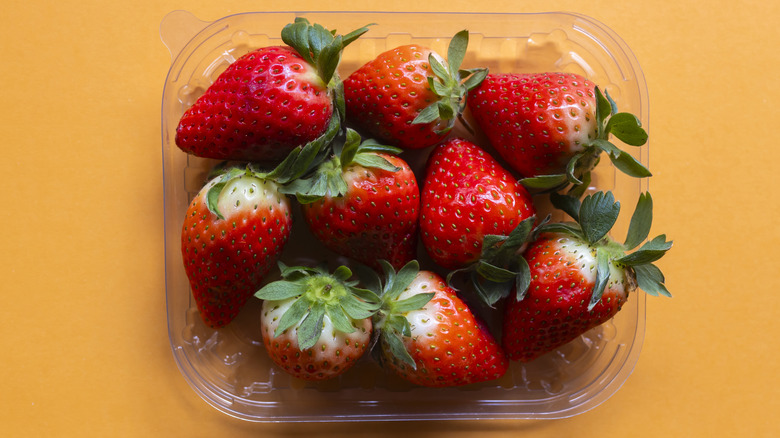The Best Temperature For Storing Strawberries And Maintaining Their Quality
Fresh, ripe strawberries are one of life's little pleasures, and while there are countless ways to enjoy them — strawberry rhubarb pie, anyone? — we find that simply eating them straight from the container is sometimes best. Once you bring them home from the farmers market or grocery store, however, the clock starts ticking on how long you have to eat them before they begin to spoil. Strawberries are good for up to five days, and if you want them to last on the longer end of that range, it's important to store them at the appropriate temperature. What might that be? No lower than 32 degrees Fahrenheit, but no warmer than 34 degrees.
Since refrigeration technically begins at 40 degrees Fahrenheit and below, you might need to adjust your fridge's temperature to fall within the ideal range for preserving strawberries. This also means that if you were keeping your strawberries on the counter, you were definitely doing them a disservice — they require cooler temperatures to slow their inevitable molding.
Strawberries don't just need a cold environment
Keeping your strawberries cold is just one part of delaying their eventual spoilage. They also need to stay as dry as possible. For many, this means going against everything you thought you knew about storing berries — no more rinsing them as soon as you get them home. In fact, you shouldn't rinse them at all until you're ready to eat them, not even in a vinegar or baking soda bath. The reason is that once you expose strawberries to that much moisture before storage, it's nearly impossible to fully dry them. That lingering moisture often leads to mold.
The best way to store strawberries is in your refrigerator, unrinsed, in a tightly sealed mason jar — in this case, they might even last up to a week. Then, rinse them as you need them, either in your hand or in a colander under cool water (don't soak them), dry them thoroughly with a paper towel, and use them as planned.
Since you can't hold back time forever, you'll know your strawberries are starting to spoil when they develop squishy, discolored patches or even a bit of slime. Mold is a definite sign that the strawberry should be thrown out; however, you can get away with discarding just the rotten or moldy ones — along with any that were touching them — and eating the rest, as long as they still look good.
Freezing strawberries can also extend their lifespan
There's another temperature range and storage space where strawberries keep well — below 32 degrees Fahrenheit. Fresh strawberries do very well flavor-wise in the freezer (though their texture does suffer a bit), and they retain their best quality for up to six months. This makes freezing a great solution for extending the life of summer strawberries into fall and winter. The best way to freeze your own strawberries is to rinse and dry them very thoroughly, then flash-freeze them in a single layer on a baking tray. Once they're firm, transfer them to an airtight container — either a plastic food bin or a zip-top freezer-safe bag. This keeps them from sticking together, so you can take only what you need.
Remember, strawberries lose some of their original texture once thawed, so this storage method isn't ideal if you're planning to eat the berries plain. However, they are fantastic in their frozen state for smoothies — such as in this strawberry basil smoothie — or blended cocktails. You could also thaw them and use them as a pie filling. If your frozen strawberries are cut into smaller pieces, you can even fold them directly into hot oatmeal — the heat will thaw the berries, while they help cool the oatmeal so you don't burn your mouth on the first bite. Win win!



